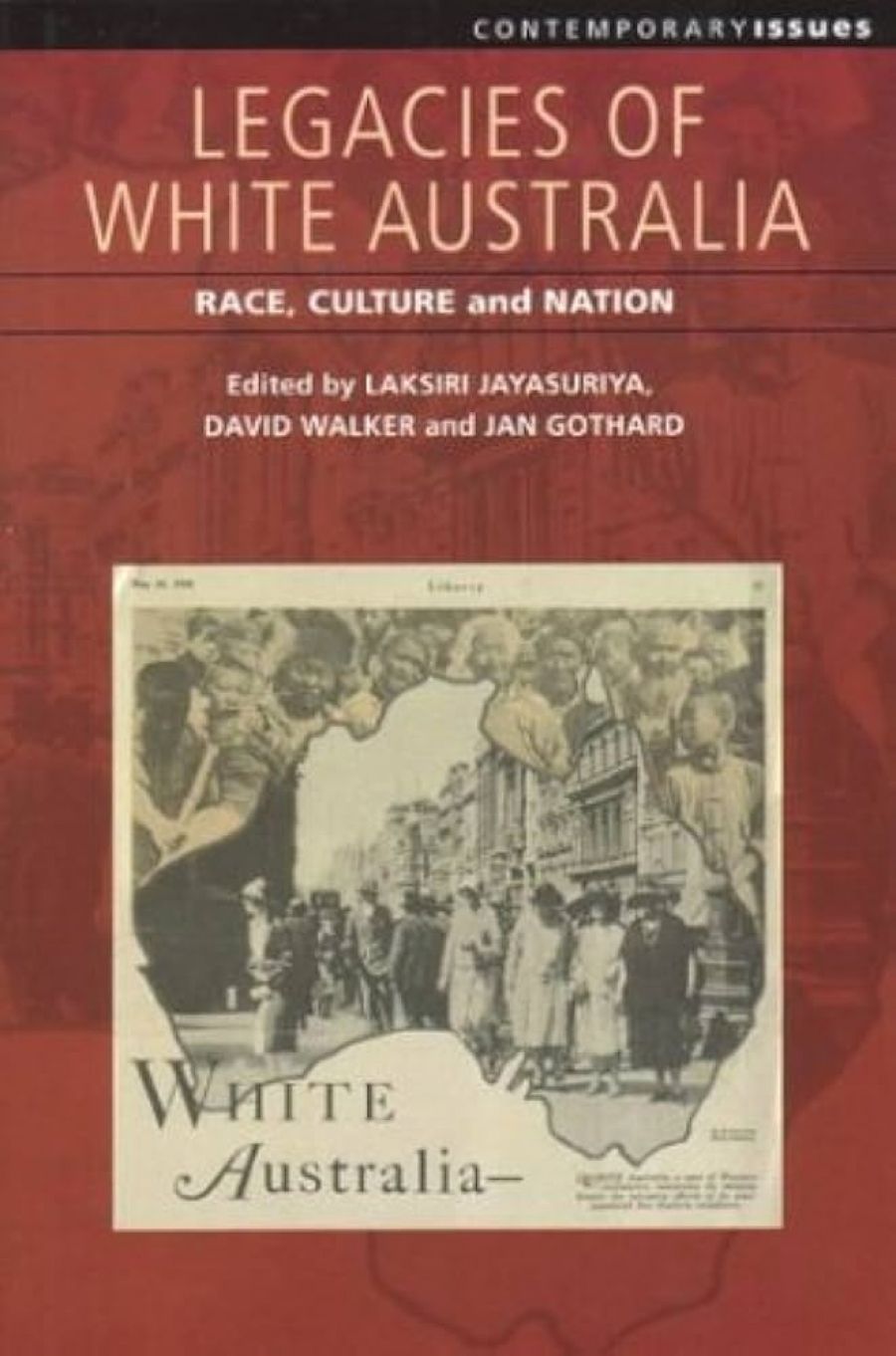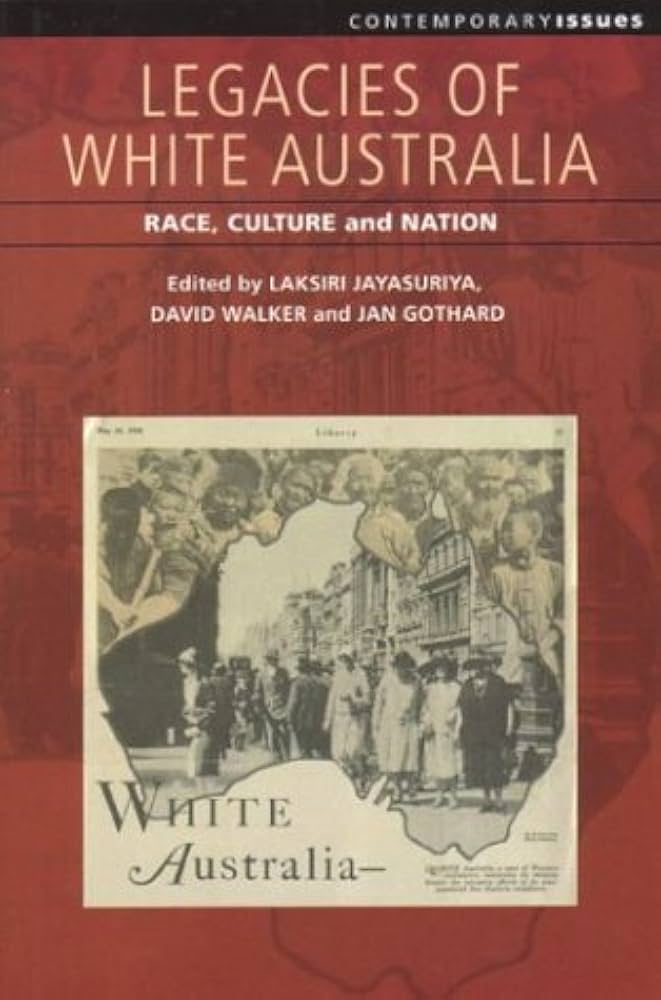
- Free Article: No
- Contents Category: Essay Collection
- Review Article: Yes
- Article Title: White Legacies
- Online Only: No
- Custom Highlight Text:
When the MV Tampa entered Australian waters in 2001, the ensuing row over its 433 Afghan passengers ignited renewed debate about immigration, citizenship and national identity. The Howard government’s subsequent re-election on a platform of border protection and security coincided with the centenary of the first substantial legislation passed by the newly constituted Parliament of the Commonwealth of Australia. The Immigration Restriction Act (1901) was the centrepiece of the White Australia Policy and reflected the new nation’s desire to regulate the composition of its population and culture, free from British interference. This collection of essays, authored by some of the country’s foremost academics in law, history and politics, commemorates that anniversary. It is a timely publication, and demanding in its persistent consideration of what the Australian national project has been and what it could be in the twenty-first century.
- Book 1 Title: Legacies of White Australia
- Book 1 Subtitle: Race, culture and nation
- Book 1 Biblio: UWA Publishing, $38.95 pb, 280 pp
- Book 1 Cover Small (400 x 600):

- Book 1 Cover (800 x 1200):

From the introduction to the conclusion, Legacies of White Australia questions its title. In the wake of Tampa, each chapter is haunted by the possibility that White Australia is far from finished. Indeed, several contributors highlight the lack of a clear end to the White Australia Policy, let alone the attitudes and populist sentiments it fostered. Ann Curthoys, in her history of the background to the 1901 Act, and Robert Manne, in his account of the Tampa affair, point to the exclusive and inclusive faces of liberal democracy, and the increasing polarisation of public opinion since 1996. Many essays identify a stiff resistance to a multicultural ethic based on pluralism rather than a paradigm of inclusion / exclusion. Andrew Markus attributes this development to ‘too much change too fast’ in the 1970s and 1980s, and reactionary nostalgia for a consensus on national identity such as that which held sway in the first half of the twentieth century.
At the heart of the ideal white Australia was not immigration policy alone but also the future of indigenous people. This subject is touched upon in a number of chapters, most notably Markus’s discussion of the politics of race in twentieth-century Australia. Yet some fundamentals must still be teased out. What is the relationship between attempts to regulate both immigration and indigenous lives? Assimilation was one common thread, although it had diverse effects. In this light, one wonders to what extent the Commonwealth government’s allocation of the immigration and indigenous affairs portfolios to one Minister is another contemporary reflection of white Australia.
The centrality of racial thinking to the Australian nationalist project is cogently related by David Walker’s chapter, and further pursued by Sean Brawley’s argument that the ideology of white Australia was a determinative factor in foreign policy. According to Brawley, the nation’s need to govern who could and could not come to its shores led it, initially, to pursue involvement in the United Nations and, later, to resist its interventions.
Two innovative studies are provided by Ien Ang and Hilary Carey. By analysing the geography and culture of white Australia, Ang links together a variety of phenomena, from Hansonism and fears of invasion to the deep-seated view of Australia as an isolated island and the Pacific Solution, ending with problems posed to white interests by the outstanding academic achievements of Asian students. Carey considers the role played by religious belief in 1901 and concludes that religion has had little to do with white Australia. Whether religion is to become a more pressing issue remains to be seen, given the prevailing stereotypes of Islam.
Was the White Australia Policy a success? While the demographic reality has changed markedly over the twentieth century, to what extent has Australian culture remained profoundly European? Gavin Jones points out that the proportion of the population of Asian descent might rise to twenty per cent by 2025, but certainly no higher, and that this is unlikely to alter most cultural and political institutions. A far greater transformation would occur, as Alistair Davidson and Kim Rubinstein argue, if the Constitution was amended to incorporate a definition of citizenship and a bill of rights, both of which it currently lacks. How would the treatment of refugees, permanent and temporary residents shift if the legal definition of citizenship was clarified and reflected the 150 different ethnicities found in Australia today?
Legacies of White Australia is often at its best when it tells stories of how policy and ideology impacted upon individual lives. Some of the incidents related have considerable power, such as the letter Laksiri Jayasuriya received from Bart Srhoy on his experiences in Australia subsequent to his emigration from Croatia in 1938, or the story told by Manne of the Iraqi refugee on a temporary protection visa who could not join his wife in Indonesia after their daughters drowned as the government would not allow him to re-enter the nation.
Jayasuriya rounds off the volume with a passionate discourse on the need for a new Constitution, a new framework for debate and a new notion of citizenship and rights in order to support a multicultural, compassionate Australia in the future. Yet I am not convinced that in the current climate this book could change the Howard Government’s mind on immigration, border protection and foreign policy. Indeed, the prime minister might relish the comparison with Henry Parkes, who in 1888 refused to allow fifty-nine legal Chinese immigrants on board the Afghan to land in Sydney and then rushed through legislation to prevent challenges to his decision. It is clear that white Australia’s legacies to the twenty-first century are yet to be determined, and these essays make a significant contribution to that future.


Comments powered by CComment